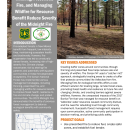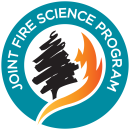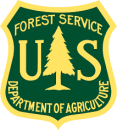Location



















States
New MexicoEcosystem
ForestIntroduction
Frequent, low-intensity fires maintain ecosystem health and biodiversity in New Mexico's fire-adapted forests. The absence of periodic fires can lead to unnatural density, increasing susceptibility to high-intensity wildfires. However, it's crucial to recognize that some vegetation communities, such as wet mixed conifer and spruce-fir forests, are naturally dense and have evolved without frequent fires. Climate change alters fire patterns and increases the risk of extreme fires that degrade wildlife habitat. Large stand-replacing fires can shift landscapes from ponderosa pine (Pinus ponderosa) to shrub oak (Quercus spp.) dominance. Shrub oaks resprout quickly post-fire, outcompeting pines. This transition affects biodiversity, decreasing species diversity as many organisms depend on ponderosa pines, and alters fire regimes.
A history of fire suppression practices, high-grade logging, historical overgrazing, and the elimination of Indigenous land management practices in the Carson National Forest (Carson NF) has increased catastrophic wildfire risks threatening communities, Indigenous lands, and wildlife habitat. When considering how to respond to increasingly severe fire in a more extreme climate, forest managers now consider when and how to help forests resist (withstanding disturbances), be more resilient to (recovery), and transition (adapting to new conditions) towards this new climate and fire reality (Sample et al. 2022).
The Rio Chama Collaborative Forest Landscape Restoration Project aimed to improve forest and watershed health across 3.8 million acres in Northern New Mexico and Southern Colorado. To support this, the West Zone of the Carson NF thinned dense forests, used prescribed fires, and managed wildfires for resource benefit in 2014, 2018, and 2019 to improve habitats, reduce hazards, and protect communities. These efforts help the forest and NF staff resist the effects of catastrophic wildfire and be more resilient to the impacts of future fires.
In June 2022, lightning ignited the Midnight Fire on the El Rito Ranger District in a Ponderosa Pine and Mixed Conifer forest. Previous thinning and prescribed fires enabled fire managers to reduce the impact and spread of the fire during extreme weather conditions. This promoted forest health, protected communities, and contributed to the ability of the forest to resist severe fire and be resilient to climate change climate change
Climate change includes both global warming driven by human-induced emissions of greenhouse gases and the resulting large-scale shifts in weather patterns. Though there have been previous periods of climatic change, since the mid-20th century humans have had an unprecedented impact on Earth's climate system and caused change on a global scale.
Learn more about climate change . Preventing the Midnight Fire from becoming catastrophic highlighted ongoing management and the importance of community involvement. Forest managers must balance ecological benefits of fire with community safety.
Key Issues Addressed
Buffer zones need to be created around communities to decrease wildfire severity and slow down wildfire spread. Methods such as thinning and prescribed fires are crucial for reducing wildfire severity and spread around communities. On the Carson NF, managers used a "catcher mitt" approach, strategically treating areas like the Alamosa Prescribed Fire units and using the lightning-caused Francisquito Fire to reduce fuel loads west of the Village of Vallecitos.
Managing fires for ecological benefits offers an effective and cost-efficient solution for treating large, remote areas of forests that are impractical or too expensive to manage through traditional methods like thinning or prescribed fires. These rugged areas benefit from low- to moderate-intensity wildfire because the forest can achieve management goals over large areas of land. By carefully guiding the fire's progress, managers reduce fuel loads, promote forest health, and create natural barriers against future severe wildfires. Allowing fire to play its natural role in the ecosystem not only improves a forest’s resiliency, it also reduces the risk to first responder and nearby communities.
The 2017 Bonita Fire that was managed for resource benefit burned severely in one area, while most of the fire saw excellent moderate to low fire effect in a mosaic. The areas that burned more severely impacted Vallecitos' surface water. Monsoon rains washed sediment from the burn area into the village's drinking water system. This impact on water resources caused the local community to distrust the Forest's efforts to manage wildfires in such a way on the landscape. The unexpected impact on water resources required rebuilding social licenses in Vallecitos through community involvement. Successful forest management must include open and transparent communication, actively involving local communities in decision-making, and demonstrating a commitment to prioritizing public safety. Without these connections and partnerships, carrying out fire management activities becomes difficult.
Project Goals
- Implement prescribed fires to mitigate wildfire severity by reducing fuel density, removing ladder fuels, creating safer zones for fire crews, improving forest resilience, and establishing strategic fuel breaks that limit fire spread and allow for more effective fire management to help protect communities.
- Use thinning and prescribed fires to successfully control wildfires to make forests more resilient over large areas of land to withstand the stresses of prolonged dry spells and more frequent heat waves.
- Build community trust and engagement by increasing communication about fire risks, prescribed fires, thinning, and managing wildfires for ecological benefits, while engaging local officials and first responders to ensure public safety.
Project Highlights
Collaboration Flows and Forests Grow: The Rio Chama Watershed, where the Midnight Fire Burned, provides 1/3 of New Mexico's drinking water and sustains rural economies in Colorado & New Mexico.
- Past Prescribed Fires Slow Spread of Wildfire and Protect Communities: The Alamosa prescribed fires spanned 4,400 acres in 2014 and 2,833 acres in 2018 surrounding the Village of Vallecitos. When the Midnight Fire came through, it slowed down and firefighters were able to prevent it from causing damage to the community of Vallecitos.
- Past Thinning and Prescribed Fires Improve Success of Managing Wildfire: The 2019 Francisquito Fire covered 2,021 acres. The lightning-caused fire burned within designated boundaries due to pastthinning and prescribed fires reducing fuel loads in advance.
- Previous Burns Reduce Fire Severity During Midnight Fire: When the 2022 Midnight Fire reached the boundary of the 2019 FrancisquitoFireburn area, fire behavior became less extreme due to the reduction of burnable fuels after the Francisquito Fire. Flame heights plummeted from 200-300 feet to 2-3 feet within minutes, and fireseveritytransitioned from high to medium to low. This allowed firefighters to safely access and suppress the Midnight Fire.
- Restoring Trust and Addressing Concerns with Fire Impacts: The Carson NF was very aware of community memory and concerns resulting from the Bonita Fire and took extra precautions during the Poso Fire with great success. During the Poso Fire in 2021, fire managers focused on directing the fire into Borracho Canyon, the headwaters of Vallecitos’ water source, to reduce fuel loading and mitigate effects of potential future catastrophic fire effects. Night operations were also conducted to reduce smoke impacts to the community.
Lessons Learned
The Carson NF uses a strategic fire management approach. By beginning with thinning operations followed by prescribed fires, fire and fuels staff can manage large burns and wildfires effectively. The sequence of previous forest treatments used by Carson NF staff proved effective in managing the Midnight Fire. Despite extreme weather where high winds and dry conditions caused the fire to expand rapidly overnight, the fire's intensity significantly decreased when it reached areas that had previously experienced fire.
Over the years, managers at the Carson NF have created a mosaic of areas that have been thinned and burned over the years. This has allowed managers to safely use wildfires to treat larger landscapes in a cost-effective manner while meeting their goals of reintroducing fire to the land to play its natural role in restoring and maintaining ecosystem health. This approach has helped increase the pace and scale of restoration work and yields both long- and short-term benefits including: improved watershed health, enhanced community safety, increased fire resilience, sustainable land use, economic opportunities, improved recreation experiences, wildlife habitat conservation, increased biodiversity, and overall ecosystem sustainability and resiliency.
Disrupting natural processes often leads to severe, long-lasting consequences. Managing wildfires for ecological benefit can be a safe, effective forest management tool, typically requiring fewer resources than extensive thinning and less intensive environmental review than prescribed fires. However, wildfires that are managed for resource benefit are still evaluated based on forest plan guidance, and best management practices and environmental guidelines continue to apply. Fire management often involves balancing multiple objectives within a single fire event, such as managing remote areas for resource benefit while prioritizing protection in urban interfaces, sometimes accepting limited environmental impacts to safeguard high-value assets.
The Carson NF increases communication efforts through multiple approaches. Before fire events, the Forest posts prescribed fire plans on Facebook and holds community meetings to educate residents about fire's role in forest management. It explains burn locations, acreage, and expected benefits. During fires, Carson NF staff hold informal kitchen table discussions with concerned neighbors as they did during the Francisquito Fire, and organize larger presentations at community centers covering various prescribed fire activities. After prescribed fires, the Forest public affairs officer shares results and impacts through Facebook and community meetings. They discuss outcomes of prescribed fires and wildfires, highlighting successes and lessons learned. The Carson NF engages with local county officials, local volunteer fire departments, and residents to maintain public trust. This pre- and post-fire communication approach keeps the community informed about the Carson NF’s fire management strategies and their effects on the forest ecosystem and community safety.
Next Steps
- Implement a Carson NF 10-year strategy involving increased resources for thinning and prescribed fires, year-round prescribed fire crews, and a focus on fire ecology and planning. Planning efforts and resource availability are crucial for maintaining the health and resilience of these fire-adapted ecosystems in the face of a changing climate and evolving fire patterns.
- Retain year-round staff, provide higher firefighter wages, and build a team that is skilled in planning, mapping, and fire ecology for sustainable fire management.
Funding Partners
- United States Forest Service, Carson National Forest
- Southwest Fire Science Consortium
- Joint Fire Science Program
- New Mexico Game and Fish
Resources
- Carson National Forest Webpage
- Carson National Forest Plan Revision
- Goodnight, Midnight Video
- Francisquito and Rincon Fires of 2019
- Sample et al. (2022) Adaptation Strategies and Approaches for Managing Fire in a Changing Climate. Climate 10(4), 58
Contacts
Angie Krall, USFS: angela.krall@usda.gov
CART Lead Author
Marci Caballero-Reynolds, CART Student Case Study Author, University of Arizona
Suggested Citation
Caballero-Reynolds, M.,L. (2024). “Thinning, Prescribed Fire, and Managing Wildfire for Resource Benefit Reduces Severity of the Midnight Fire.” CART. Retrieved from https://www.fws.gov/project/thinning-prescribed-fire-and-managing-wildfire-resource-benefit.









